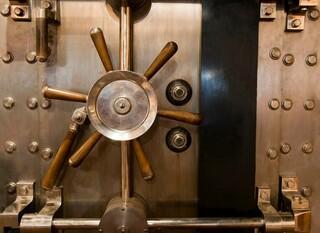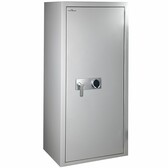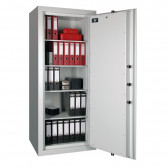It might seem that a safe is a simple device that does not require complicated maintenance. However, there are sometimes problems with the lock, hinges and locking mechanism. If you are thinking of buying a safe or already own one, check what to do in emergency situations. Problems can arise, among other things, if you receive a safe as an inheritance or when buying a property. Emergency lock opening is not that easy and you may need help of a professional. See how you can easily deal with a locked safe.
Emergency opening of a key lock safe
Key locks are characterised by their simple design and are therefore considered reliable and durable. Despite their advantages, they also can be damaged. All it takes is for someone to try to open the safe with a different or damaged key. There are also cases where a key is broken and a part of it is left inside the lock.
Emergency opening of a safe with a key lock is not easy. If this operation is undertaken by an unskilled person, the lock may be permanently damaged. If you want to deal with the problem, enlist the help of professionals. A professional service will do everything possible to remove the fault without interfering with the lock mechanism.
Emergency opening of a combination lock
Mechanical combination locks with a rotating dial are very good security for a safe. Unfortunately, twisting the cipher requires skill and precision.
If you cannot open the safe, this does not at all mean that the mechanism has been damaged. It is often the case that the user forgets the cipher. First of all, make sure that you dial the correct code.
There are also cases where the cipher is dialed imprecisely. All it takes is a minor mistake and the door will not open. Note that there are a hundred graduations on the dial. Try to enter the cipher accurately. If this does not help, you will be forced to call in the professionals.
Do not use an ordinary locksmith. He may damage the lock mechanism. Contact the manufacturer first, who will advise you on what to do. Have the emergency opening of your combination lock carried out by a professional service that will deal with it quickly. Afterwards, you will be able to continue using the safe.
Check out, too: Opening different types of locks on safes
Operating instructions for a safe equipped with various types of locks
Emergency opening of a safe with an electronic lock
Electronic locks are characterised by the fact that they require electricity to operate. Models with a numeric keypad are powered by batteries. Biometric fingerprint locks and those opened with a smartphone require a permanent connection to the mains.
If you have a problem with a lock with a numeric keypad, first check whether the batteries need to be changed. A replacement of the batteries is sufficient in many cases.
Safes with electronic locks sometimes have a revision, i.e. the ability to open with a key. In the event of an emergency opening of the safe, you do not need to call a professional right away. Check the manual to see where the revision is located.
Emergency opening of an electronic safe can only consist of pulling off the front panel. To do this you will need a set of keys and a screwdriver. This is an easy way to get to the revision and open the lock.
If the lock is not equipped with a revision, you will also need to use an authorised service.
Service and operation of the safe
If you want to use the safe for a long time and without problems, use the manufacturer's service. Any self-repair and interference with the lock mechanism may invalidate the guarantee.
For your own safety, do not inform ordinary locksmiths that you have a safe. Report any faults to the manufacturer, who will rectify the problem discreetly if necessary.
Operating the safe is not complicated but do not over-clean the locking mechanism or the lock. Use only a damp cloth and mild detergents to remove dirt. Chlorine-based and other caustic agents can damage the paintwork. You can use extraction petrol to get rid of larger dirt.
What to do with a damaged safe?
Emergency opening of a safe can end up damaging it. An armoured cabinet can also be damaged in a fire or flood, or during an attempted burglary. What should you do in such a case?
If your safe has been damaged, contact a service that will not only open the damaged lock, but also dispose of the broken safe if necessary. You need to know that any failure such as flooding, fire or attempted burglary renders the armoured safe unfit for further use.
If you continue to use a damaged safe, your insurer may refuse to pay out compensation in the event of theft. Take care of your security and order a new safe. Before you pick up a newer model, you can rent a replacement safe from the manufacturer.
As you can see, the emergency opening of a safe is not as scary as it may seem. Above all, you should not panic and forcefully interfere with the lock mechanism. Have any work done by a professional. However, it is not worth calling in a random locksmith. An inexperienced workman will damage the safe and you will lose your guarantee.





